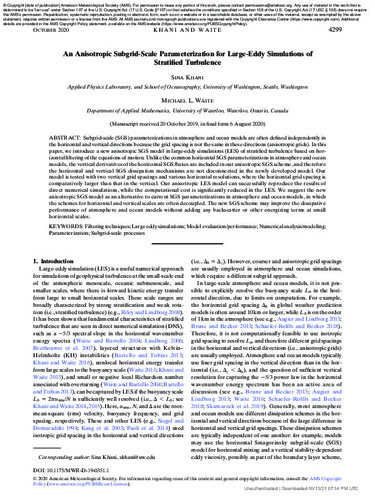| dc.contributor.author | Khani, Sina | |
| dc.contributor.author | Waite, Michael L | |
| dc.date.accessioned | 2021-10-19 19:54:04 (GMT) | |
| dc.date.available | 2021-10-19 19:54:04 (GMT) | |
| dc.date.issued | 2020-10-01 | |
| dc.identifier.uri | https://doi.org/10.1175/MWR-D-19-0351.1 | |
| dc.identifier.uri | http://hdl.handle.net/10012/17656 | |
| dc.description | © Copyright 2020 American Meteorological Society (AMS). For permission to reuse any portion of this work, please contact permissions@ametsoc.org. Any use of material in this work that is determined to be “fair use” under Section 107 of the U.S. Copyright Act (17 U.S. Code §?107) or that satisfies the conditions specified in Section 108 of the U.S. Copyright Act (17 USC § 108) does not require the AMS’s permission. Republication, systematic reproduction, posting in electronic form, such as on a website or in a searchable database, or other uses of this material, except as exempted by the above statement, requires written permission or a license from the AMS. All AMS journals and monograph publications are registered with the Copyright Clearance Center (https://www.copyright.com). Additional details are provided in the AMS Copyright Policy statement, available on the AMS website (https://www.ametsoc.org/PUBSCopyrightPolicy). | en |
| dc.description.abstract | Subgrid-scale (SGS) parameterizations in atmosphere and ocean models are often defined independently in
the horizontal and vertical directions because the grid spacing is not the same in these directions (anisotropic grids). In this
paper, we introduce a new anisotropic SGS model in large-eddy simulations (LES) of stratified turbulence based on hor izontal filtering of the equations of motion. Unlike the common horizontal SGS parameterizations in atmosphere and ocean
models, the vertical derivatives of the horizontal SGS fluxes are included in our anisotropic SGS scheme, and therefore
the horizontal and vertical SGS dissipation mechanisms are not disconnected in the newly developed model. Our
model is tested with two vertical grid spacings and various horizontal resolutions, where the horizontal grid spacing is
comparatively larger than that in the vertical. Our anisotropic LES model can successfully reproduce the results of
direct numerical simulations, while the computational cost is significantly reduced in the LES. We suggest the new
anisotropic SGS model as an alternative to current SGS parameterizations in atmosphere and ocean models, in which
the schemes for horizontal and vertical scales are often decoupled. The new SGS scheme may improve the dissipative
performance of atmosphere and ocean models without adding any backscatter or other energizing terms at small
horizontal scales. | en |
| dc.description.sponsorship | Funder 1, financial support provided by National Science Foundation through Awards 1536360 and 1536314 || Funder 2, M.L.W. gratefully acknowledges support from the Natural Sciences and Engineering Research Council of Canada (Grant RGPIN-386456-2015). | en |
| dc.language.iso | en | en |
| dc.publisher | AMS | en |
| dc.relation.ispartofseries | Monthly Weather Review; | |
| dc.subject | Filtering techniques | en |
| dc.subject | Large eddy simulations | en |
| dc.subject | Model evaluation/performance | en |
| dc.subject | Numerical analysis/modeling | en |
| dc.subject | Parameterization | en |
| dc.subject | Subgrid-scale processes | en |
| dc.title | An Anisotropic Subgrid-Scale Parameterization for Large-Eddy Simulations of Stratified Turbulence | en |
| dc.type | Article | en |
| dcterms.bibliographicCitation | Khani, S., & Waite, M. L. (2020). An Anisotropic Subgrid-Scale Parameterization for Large-Eddy Simulations of Stratified Turbulence. Monthly Weather Review, 148(10), 4299–4311. https://doi.org/10.1175/MWR-D-19-0351.1 | en |
| uws.contributor.affiliation1 | Faculty of Mathematics | en |
| uws.contributor.affiliation2 | Applied Mathematics | en |
| uws.typeOfResource | Text | en |
| uws.peerReviewStatus | Reviewed | en |
| uws.scholarLevel | Faculty | en |

